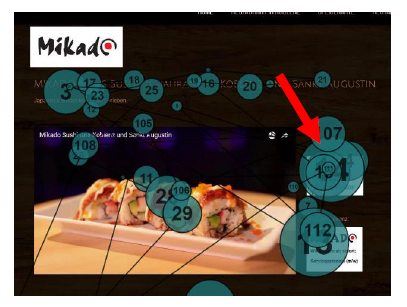Evaluations are essential for social media. When it comes to websites, however, “like” data from social media platforms is hardly noticed. They also have no positive influence on user decisions. This is the result of the current Eye-Tracking-Study of the start-up EYEVIDO and the eMBIS Academy for Online Marketing.
Hardly Any Views. No Effect.
Social media platforms such as Facebook or TripAdvisor offer website hosters the opportunity to integrate “like” data into the corresponding corporate websites. This allows website visitors to see how fans and users evaluate services or products and use this content for their decisions. So much for the theory. But do “Likes” actually influence website visitors? EYEVIDO and the eMBIS Academy for Online Marketing have investigated this question by means of eye-tracking.

The eye-tracking procedure records which points on the PC screen are fixed for how long and when based on the test subject’s eye movements. Following this technical analysis, the users were also interviewed.
Key Statements of the Study
- Approximately 30% of the test subjects did not consider likes and ratings.
- Another 30 % did not notice these evaluations and could not remember them in the survey.
- The respective website offers were not rated more positively due to the social media information.
Structure of the Study
A total of 20 participants had the task of viewing eight home pages with regard to the respective offers and special features. The test subjects were then asked if and how they would like to choose out of the individual offers. The corporate websites of three restaurants, two team event service providers, a café, a zoo and a logistics company were all on display.
Participants were divided into two groups during the course of the study: One group was shown the original home pages with embedded social media ratings from Facebook and TripAdvisor. The other group got the same start pages, but without seeing the “Like” data.
Example:

Eye Tracking Results
In a first step, the test persons looked at the respective start pages. The fixations were recorded and the retention time measured. This was around 48 seconds per website.
The eye-tracking result: Around 30% of the measured eye movements showed that the feedback elements were not viewed or only briefly seen. If the likes and ratings were perceived, then on average only after 25 seconds with a total dwell time of around 48 seconds. The average viewing time of the feedback elements was just over two seconds.
Example:

Result of the Survey
The interview consisted of three parts.
- First, the participants were asked to answer the question: “Does social media feedback play a major role in the evaluation of an offer for you? All test subjects answered this question with “Yes”.
- Subsequently, the test subjects were asked whether they had noticed the social media evaluations integrated on the last home page. The result:
- 30 % had not noticed the ratings.
- 30% were not sure whether there were ratings.
- 40% had taken notice of the ratings.
These answers correspond to the result of the eye tracking data: Test subjects who could not remember reviews or had not noticed them had demonstrably not focused on the social media feedback. The eye movement paths of the eye-tracking method clearly differentiate the two evaluations from each other. To illustrate this, here are the eye movement paths and the feedback of two participants: circles indicate the focus points, numbers the order of focus points.


- After viewing the respective start page, all test subjects were asked whether they would choose the respective offers. The result. The test subjects were not positively influenced by the visibly embedded social media feedback: For example, many Facebook likes on a restaurant website were no reason for the participants to go out to dinner.
Conclusion: “Like” Data on Websites is Ineffective
Based on the banner blindness, i.e. the effect of the fading out of advertisements by website visitors, the study shows a social media blindness: website visitors perceive social media ratings only barely or not at all. They do not even remember having seen them and do not let themselves be influenced in their decision-making by social media feedback.

